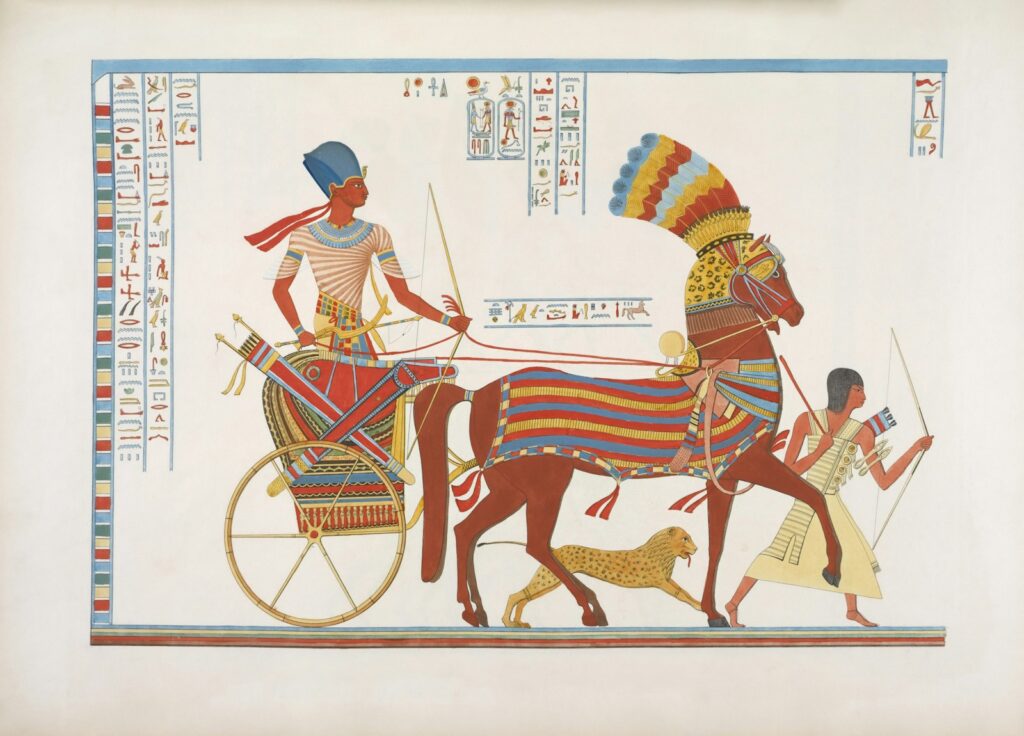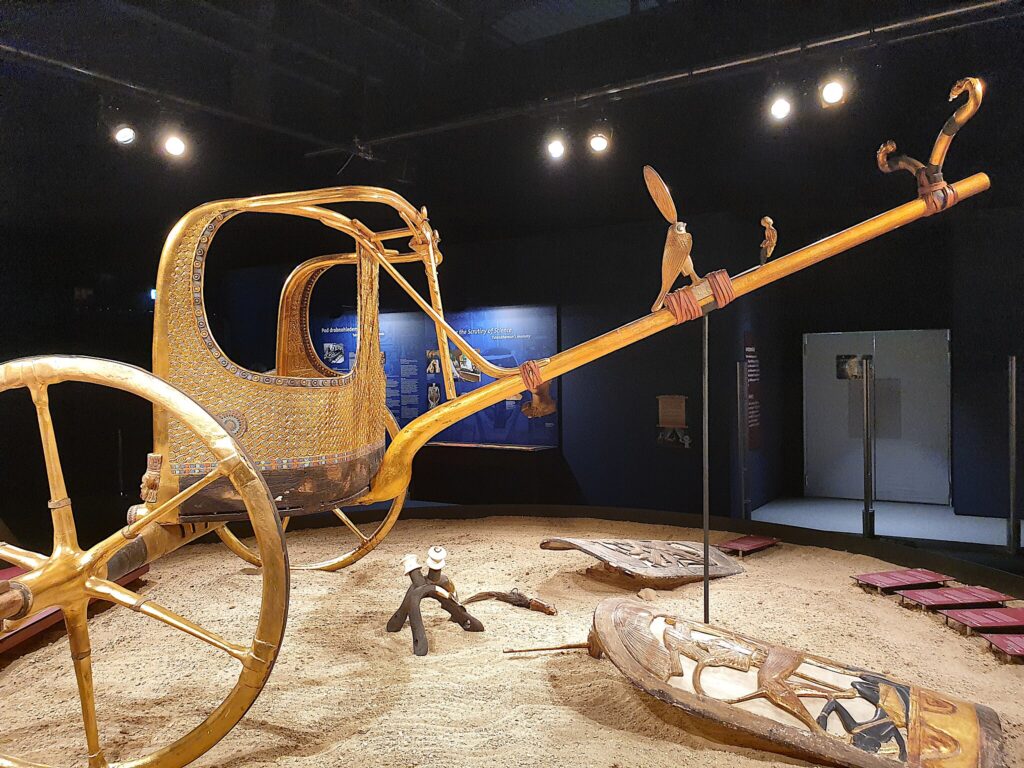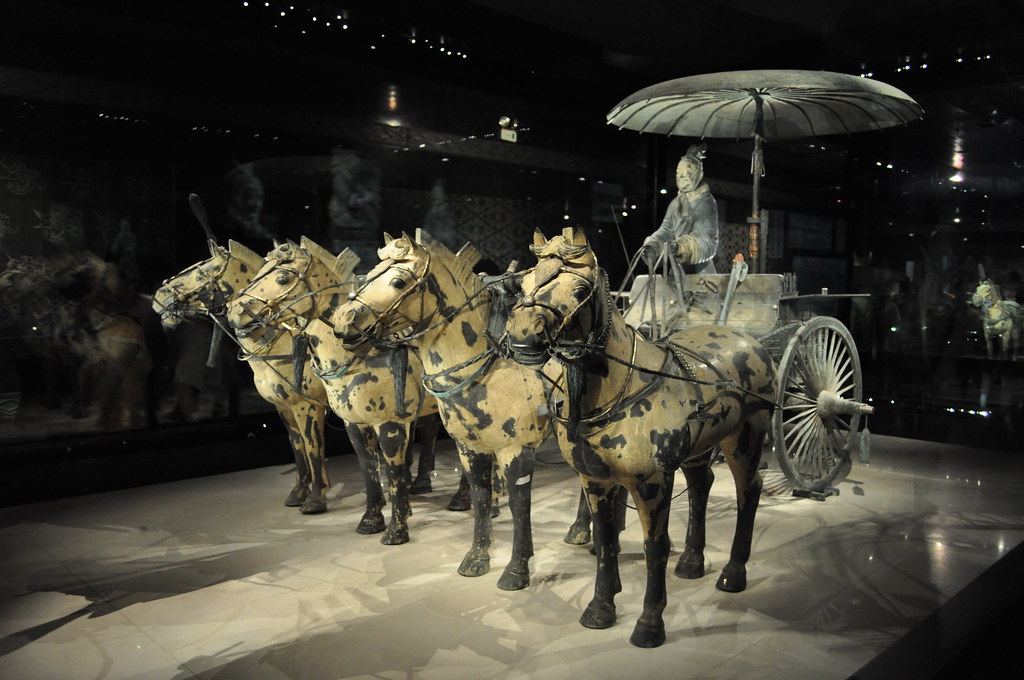The thundering hooves, gleaming bronze, and fearsome speed of war chariots dominated ancient battlefields for nearly two millennia. At the heart of this revolutionary military technology was the horse – not just any horse, but animals specifically selected and rigorously trained to perform in the chaos of combat. Ancient civilizations from Egypt to China developed sophisticated methods for preparing horses to pull chariots into battle, transforming naturally skittish prey animals into disciplined warfare assets. The relationship between these magnificent animals and their human handlers represents one of history’s most remarkable examples of animal training, combining careful breeding, systematic conditioning, and an intimate understanding of equine psychology. This article explores how ancient civilizations transformed horses from wild creatures into the engines of history’s earliest mechanized warfare.
The Evolution of War Horses and Chariots

War chariots first appeared around 2000 BCE in Mesopotamia, revolutionizing warfare by combining the speed of horses with a mobile fighting platform. Early domestic horses were smaller than modern breeds, standing approximately 14 hands high (about 56 inches at the shoulder), but were selected for strength, endurance, and trainability. The development of effective chariot horses happened alongside technological improvements in chariot design, creating a co-evolutionary relationship between animal breeding and vehicle engineering. As chariot warfare spread throughout the ancient world, different civilizations adapted training methods to suit their specific military needs and cultural contexts, though certain fundamental approaches remained consistent across cultures.
Selection of Suitable Horses

Not all horses were considered appropriate for chariot warfare, and ancient handlers were remarkably discerning in their selection process. The Hittites, who created some of the earliest known texts on horse training around 1350 BCE, specified horses with certain proportions, temperaments, and physical capabilities. Egyptian artwork shows a preference for horses with arched necks, compact bodies, and alert expressions – qualities still valued in modern show horses. Ancient trainers looked for animals with good recovery rates after exertion, sound feet and legs, and most importantly, courage and responsiveness under stress. Chinese texts from the Zhou dynasty period (1046-256 BCE) described the ideal chariot horse as having “dragon bones” – presumably meaning strong, well-defined conformation.
Age-Based Training Systems

Ancient horse trainers implemented progressive training systems based on the animal’s age and development stage. According to surviving Hittite texts, training often began when horses were two years old with simple habituation to human handling and equipment. By age three, horses would be introduced to the weight of harness equipment and basic voice commands. Four-year-old horses began pulling lightweight training chariots under controlled conditions. Full battle training typically commenced in the horse’s fifth year, when the animal’s physical and mental maturity could handle the rigors of combat conditioning. This systematic approach prevented physical and psychological damage from premature stress on young animals.
Desensitization Techniques

Perhaps the most crucial aspect of preparing horses for battle was systematic desensitization to the sights, sounds, and sensations of warfare. Ancient trainers would gradually expose horses to potentially frightening stimuli: flapping fabrics simulating banners, clanging metal, sudden movements, and crowds of people. The Assyrians, renowned for their chariot warfare, created training environments where horses would navigate through artificial smoke and fire to prepare them for battlefield conditions. Egyptian trainers reportedly used drums and horns during feeding times to create positive associations with battle noises. Archaeological findings suggest some civilizations used special training grounds with obstacles, uneven terrain, and water features to condition horses for varied battlefield environments.
Specialized Diet and Care

War chariot horses received exceptional care and specialized diets reflecting their military value. The Mari tablets from Mesopotamia (circa 1800 BCE) detail rations for chariot horses that included barley, specialized grasses, and even honey and wine for performance enhancement. Egyptian records indicate royal chariot horses received higher quality feed than other livestock, with specific feeds reserved exclusively for military horses. Grooms followed strict protocols for the animals’ physical maintenance, including specialized grooming techniques to maintain coat health in hot climates and hoof care for improved traction and durability. Regular rest periods were incorporated into training schedules to prevent exhaustion and maintain the horses’ physical and mental well-being.
Team Training and Matching

Chariot horses worked in teams, typically pairs (a biga) or four-horse teams (a quadriga), requiring specialized training for cooperative movement. Trainers carefully matched horses for size, stride length, temperament, and strength to ensure balanced pulling and coordinated movement. Mesopotamian texts describe exercises where horses learned to maintain even pressure on the draught pole and coordinate their gaits. Egyptian tomb paintings show training scenes where horses practice turning in unison while maintaining formation. Chariot teams often trained together for years, developing the synchronization necessary for the sharp turns and rapid maneuvers required in battle scenarios.
Harness and Bit Technology

The development of appropriate harnessing systems was essential for effective chariot use and directly influenced training methods. Early chariot harnesses distributed weight across the horse’s shoulders using a specially designed collar, rather than around the neck and windpipe as in earlier designs, allowing horses to pull heavier loads without choking. The introduction of the jointed snaffle bit around 1300 BCE by the Hittites revolutionized steering control, allowing for more precise communication between driver and horse team. Specialized training bits, often more severe than those used in actual battle, have been found in archaeological contexts, suggesting they were used during the conditioning phase to establish control before transitioning to standard equipment. Horses were systematically habituated to their equipment through progressive training steps, beginning with simple halters before advancing to full battle harness.
Command Training and Response Conditioning

Ancient chariot drivers needed horses to respond instantly to commands in battle, where hesitation meant death. Training focused on creating consistent responses to voice commands, pressure cues from the reins, and weight shifts in the chariot. The Hittite Kikkuli text describes a training sequence where horses learned specific responses to distinct verbal and physical signals. Evidence suggests that ancient trainers used both negative reinforcement (removing pressure when the horse complied) and positive reinforcement (food rewards) to establish reliable command responses. Egyptian tomb art shows drivers holding reins in specific positions, indicating a sophisticated system of rein aids similar to modern driving techniques.
Endurance and Conditioning

Battlefield effectiveness required extraordinary physical conditioning for chariot horses. The famous Kikkuli text outlines a sophisticated 214-day training program involving carefully measured exercise, controlled sweating, and specific cooling-down procedures. Archaeological evidence shows exercise areas near ancient military installations where horses would be conditioned using carefully designed training circuits. Long-distance conditioning involved progressive increases in workload, with horses pulling empty chariots before graduating to weighted vehicles. Chinese records from the Warring States period describe chariot horses being exercised daily over varied terrain to build cardiovascular endurance and sure-footedness.
Battle Formation Training

War chariots rarely operated alone, instead functioning as part of larger tactical formations that required specialized training. Horses needed to maintain specific positions relative to other chariots while moving at speed across uneven terrain. Egyptian military texts describe exercises where multiple chariot teams practiced maintaining precise distances between vehicles while executing synchronized maneuvers. Archaeological evidence from chariot burial sites in China suggests horses were trained to maintain steady speeds in groups, demonstrated by the uniform wear patterns on recovered harness components. Assyrian palace reliefs show chariots moving in precise lines during battle, indicating extensive formation training.
Psychological Conditioning for Combat

Perhaps most remarkably, ancient trainers developed methods to overcome horses’ natural flight instinct, conditioning them to charge toward danger rather than away from it. This psychological conditioning involved gradual exposure to stressful stimuli while under control, creating a new response pattern. Egyptian texts refer to “heart training” where horses learned to trust their drivers’ guidance even in frightening situations. Hittite trainers reportedly introduced horses to captive predators under controlled conditions to reduce fear responses. The most valuable chariot horses were those with the natural temperament and trainability to overcome their instinctive fear, making them psychologically suitable for the chaos of ancient battlefields.
Cultural Variations in Training Methods

While fundamental principles remained consistent, different civilizations developed distinctive approaches to chariot horse training. The Egyptians emphasized close bonds between horses and drivers, often assigning specific grooms and drivers to work with the same horses throughout their careers. Hittite methods focused on systematic physical conditioning, with precisely measured exercise and rest periods. Assyrian training emphasized aggressive battlefield maneuvers with horses conditioned to participate in direct combat actions. Chinese chariot horse training incorporated philosophical principles regarding harmony between horse and driver, influenced by early Taoist concepts about working with rather than against natural tendencies. These cultural variations reflected each civilization’s broader military doctrine and cultural values.
The Legacy of Ancient Horse Training

The sophisticated methods developed for training ancient war chariot horses established fundamental principles still found in modern equestrian disciplines. Many contemporary training techniques, from progressive loading to systematic desensitization, have direct parallels in ancient methods documented in surviving texts and artwork. The ancient understanding of horse psychology demonstrated remarkable sophistication, recognizing the importance of consistent handling, clear communication, and appropriate conditioning. The partnership between humans and horses established through these ancient training methods transformed warfare and transportation for millennia, creating a legacy that extended far beyond the battlefield. When cavalry eventually replaced chariots in most armies around 600 BCE, the training techniques developed for chariot horses provided the foundation for mounted warfare that would dominate battlefields until the modern era.
The training of horses for ancient war chariots represents one of humanity’s most impressive achievements in animal husbandry and behavioral conditioning. Through systematic selection, progressive training, specialized care, and psychological conditioning, ancient civilizations transformed the natural behavior of horses to create the world’s first weapon systems combining animal power with human military technology. These sophisticated training methods reflected deep understanding of equine psychology and physical capabilities, developed through centuries of close observation and practical experience. The relationship between chariot horses and their human handlers—built on trust, conditioning, and mutual dependence—helped shape the course of ancient warfare and, by extension, the rise and fall of early empires. The echoes of these ancient training methods continue to influence our relationship with horses today, serving as testament to the enduring bond between humans and these remarkable animals.







